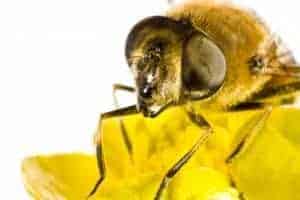How the Vision of Bees Helps Them
As with many things bee-related, the way honey bees see the world is remarkable. However, the way they see their world is in many ways similar, and in many ways very different from the way we see ours. Bees see a different spectrum of colors than we do. Bees do in fact, see color, but they see colors higher in the spectrum than humans do. When thinking about this it could be helpful to think about the colors of your typical rainbow, with red at the top, fading into your blues and purples towards the bottom. Bees cannot see the true reds at the top end of this spectrum, but can see the other colors moving down the scale.

In fact, moving in this direction bees can see even further and into the ultraviolet spectrum. While a bee’s vision is not as crisp as ours, their ability to see further into the ultraviolet spectrum, combined with their ability to see colors in the spectrum that bees and humans share, allows them to navigate their world and target specific flowers, and specific parts of those flowers.
Bees can also detect polarization of light in reference to the sun, which humans can only detect when utilizing polarizing filters or glasses. This polarization helps bees locate the sun, even on cloudy days. How much bees use their ability to see polarized light for navigation is a bit debatable, but it is likely that they use this ability at least to some extent.
While bee see the world quite differently than humans, their ability to see the world in a different light – literally – allows them to differentiate and locate various flowers, even when flying at high speed. They can also focus on important parts of those flowers with a great level of precision. In addition, their ability to see colors, ultraviolet, and polarized light helps them navigate to and from their hive and identify their home.
